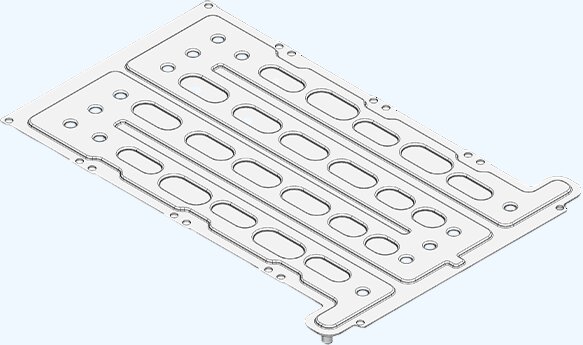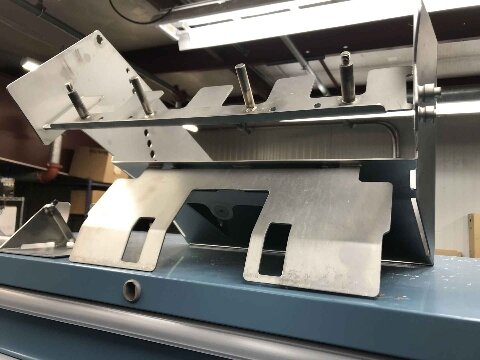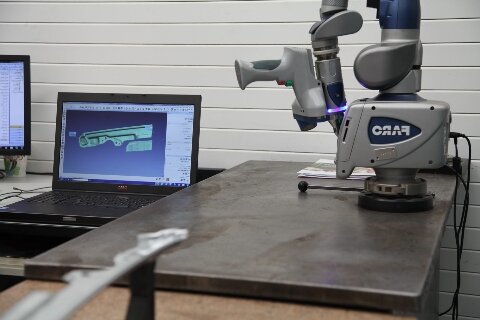Veel mensen vragen vaak: "Welke snijmethode moet ik kiezen - laser, waterstraal of plasma?". Dat is een redelijke vraag. Elke methode snijdt metaal, maar ze produceren niet dezelfde resultaten. Sommige maken gladdere randen, andere kunnen dikkere platen snijden en elke methode heeft zijn eigen kosten en snelheid.
Daarom willen we het hier bespreken. In dit artikel vergelijken we deze drie snijmethoden op basis van de prestaties in de echte werkplaats - wat ze het beste doen, hun beperkingen en wanneer ze de juiste keuze zijn.
Je leert hoe lasersnijden zich verhoudt tot waterstraal en plasma op het gebied van precisie, randkwaliteit en efficiëntie. Aan het eind heb je een duidelijk idee welke methode het beste bij je volgende project past.
Overzicht van snijtechnologieën
Snijtechnologieën spelen een belangrijke rol in de manier waarop metalen onderdelen worden gemaakt. Elke methode - laser, waterstraal en plasma - gebruikt een andere energiebron en techniek om zijn eigen resultaten te bereiken.
Wat is lasersnijden?
Lasersnijden maakt gebruik van een gefocuste lichtstraal om materiaal langs een precieze lijn te smelten of te verdampen. De bundel gaat door spiegels en lenzen om een fijn brandpunt te creëren, vaak minder dan een millimeter breed. Deze smalle, krachtige straal maakt zeer nauwkeurige sneden met kleine toleranties en gladde randen mogelijk.
Lasersnijden werkt het beste op dunne tot middel dikke materialen zoals roestvrij staal, aluminium, messing en koper. De straal beweegt snel, wat zorgt voor snelheid en consistente kwaliteit met zeer weinig materiaalafval. Het ondersteunt ook complexe vormen, scherpe hoeken en gedetailleerde patronen, waardoor het ideaal is voor zeer nauwkeurige onderdelen.
Het proces is schoon en efficiënt. Het creëert minimale bramen en vermindert de behoefte aan extra nabewerking. In combinatie met CNC-systemen produceert lasersnijden herhaalbare en betrouwbare resultaten, zelfs voor complexe ontwerpen.
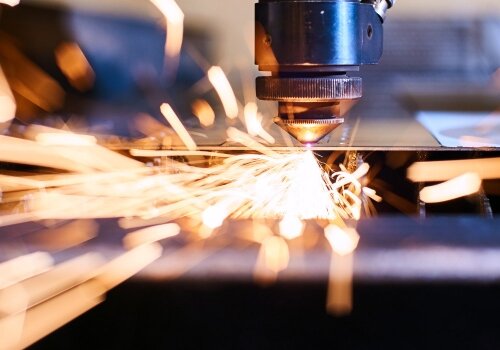
Wat is waterstraalsnijden?
Waterstraalsnijden maakt gebruik van een waterstroom onder hoge druk, vaak gemengd met schurende deeltjes zoals granaat, om door metaal, steen, glas en composietmaterialen te snijden. In tegenstelling tot laser- of plasmasnijden ontstaat er geen hitte. Deze "koud snijden" methode voorkomt problemen zoals warmtevervorming, verharde randen of kromtrekken van het materiaal.
De machine zet water onder een druk van 60.000 psi of meer en dwingt het vervolgens door een klein mondstuk. Wanneer er slijpmiddelen worden toegevoegd, kan de straal zelfs zeer taaie materialen snijden, zoals dik roestvrij staal, titanium of graniet. De snijranden zijn glad en braamvrij, waardoor vaak geen extra nabewerking nodig is.
Waterstraalsnijden is zeer flexibel. Het kan een breed scala aan materialen en diktes aan, van dunne platen tot platen van enkele centimeters dik. Het is ook perfect voor materialen die gevoelig zijn voor warmte, zoals kunststoffen of gelamineerde composieten.
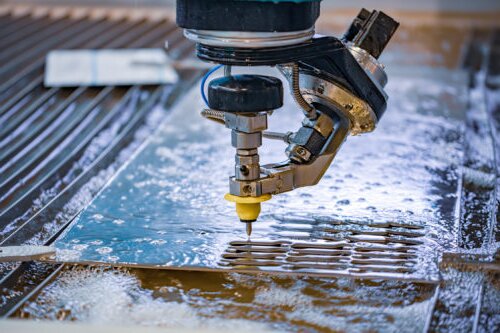
Wat is plasmasnijden?
Plasmasnijden maakt gebruik van een elektrisch geleidend gas (meestal samengeperste lucht, zuurstof of stikstof) om een hete plasmaboog te vormen. Het plasma smelt het metaal en een sterke gasstraal blaast het gesmolten materiaal weg, waardoor er een zuivere snede overblijft. Deze methode is snel en krachtig, vooral voor dikke metalen zoals staal, aluminium en koper.
Het wordt veel gebruikt in zware industrieën zoals de bouw, scheepsbouw en autoreparatie. Plasmasnijmachines kunnen door materialen van enkele centimeters dik snijden, waardoor ze waardevol zijn voor grootschalige productie- en onderhoudstaken.
Hoewel plasmasnijden niet dezelfde precisie bereikt als lasersnijden of de gladde afwerking van waterstraalsnijden, levert het een uitstekende snelheid en waarde bij het snijden van dikkere metalen platen. Het is ook een van de meest kostenefficiënte opties voor middelgrote tot grote producties.
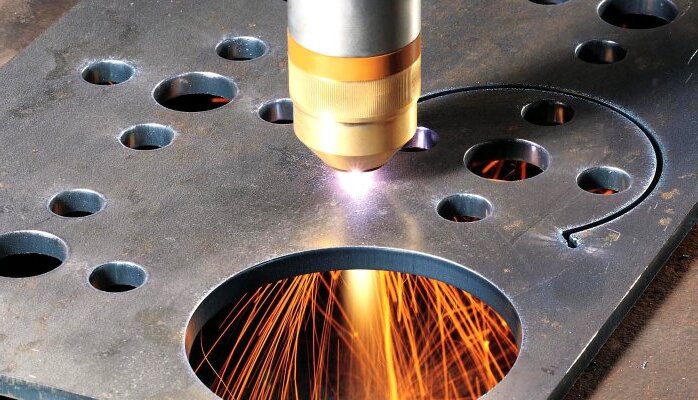
Snijnauwkeurigheid en randkwaliteit vergelijken
Het kiezen van de juiste snijmethode hangt af van hoe precies en schoon de uiteindelijke randen moeten zijn. Elk proces heeft zijn eigen sterke punten en beperkingen als het gaat om nauwkeurigheid en randkwaliteit.
Precisie en toleranties
Lasersnijden biedt de hoogste precisie. Er kunnen toleranties tot ±0,001 inch worden bereikt voor dunne tot middelzware materialen. De gefocuste straal en de kleine spot zorgen voor scherpe hoeken, krappe bochten en een consistente herhaalbaarheid. Dit maakt lasersnijden ideaal voor gedetailleerde ontwerpen en onderdelen die perfect moeten passen, zoals elektronische behuizingen of mechanische assemblages.
Waterstraalsnijden biedt ook een perfecte nauwkeurigheid, meestal rond de ±0,003 inch, afhankelijk van het materiaal en de opstelling. Omdat er water onder hoge druk wordt gebruikt in plaats van warmte, wordt kromtrekken of vervorming voorkomen. Dit helpt om stabiele afmetingen te behouden, zelfs bij dikkere of gelaagde materialen.
Plasmasnijden is weliswaar snel en krachtig, maar minder nauwkeurig dan laser- of waterstraalsnijden. Meestal worden toleranties van ±0,01 inch gehaald. De plasmaboog spreidt zich iets tijdens het snijden, waardoor de kerf breder wordt en fijne details minder nauwkeurig. Voor dikke staalplaten of belangrijke structurele componenten is deze nauwkeurigheid echter meer dan genoeg.
Randafwerking en kerfbreedte
Lasersnijden produceert gladde, schone randen met zeer weinig bramen. De kerf - de breedte van het verwijderde materiaal - is smal, vaak minder dan 0,01 inch. Dit maakt efficiënt materiaalgebruik en nauwkeurig nesten van onderdelen op een enkele plaat mogelijk. De kleine warmte-beïnvloede zone betekent ook dat er weinig of geen nabewerking nodig is, zoals schuren of ontbramen.
Waterstraalsnijden geeft een uitstekende randkwaliteit zonder hittevlekken of verkleuring. De randen zijn glad en vlak, geschikt voor zichtbare of decoratieve onderdelen. De kerf is iets breder dan die van een laser, meestal tussen 0,02 en 0,04 inch, afhankelijk van het slijpmiddel en het mondstuk. Het proces laat een zachte, matte afwerking achter die vaak niet extra gepolijst hoeft te worden.
Plasmasnijden produceert een bredere kerf, ongeveer 0,06 inch of meer. De randen kunnen ruwer en licht afgeschuind zijn, vooral bij dikkere materialen. Aan de onderkant kan zich wat slijpstof ophopen, wat meestal licht geslepen of gereinigd moet worden. Toch is plasmasnijden voor grootschalige of zware fabricage een praktische en efficiënte keuze dankzij de hoge snelheid en lage kosten.
Compatibiliteit van materialen en diktebereik
Elke snijmethode presteert anders, afhankelijk van het type en de dikte van het materiaal. Als je weet wat elke techniek het beste doet, kun je de meest geschikte optie voor je project kiezen.
Metalen en niet-metalen
Lasersnijden werkt goed met metalen zoals roestvrij staal, zacht staal, aluminium, messing en koper. Moderne fiber lasers kunnen gemakkelijk omgaan met reflecterende metalen waar oudere CO₂ lasers moeite mee hadden. Naast metalen kan lasersnijden ook dunne kunststoffen, acryl en hout verwerken, hoewel extra zorg nodig is om smelten of verbranden te voorkomen.
Waterstraalsnijden is het meest flexibel als het op materialen aankomt. Het kan metalen, kunststoffen, glas, steen, keramiek, rubber en zelfs composietmaterialen snijden. Omdat het een koud snijproces is, veroorzaakt het geen hitteschade, vervorming of verkleuring. Dat maakt het geweldig voor hittegevoelige materialen zoals titanium, koolstofvezel of gehard gereedschapsstaal.
Plasmasnijden werkt alleen met geleidende metalen, zoals koolstofstaal, roestvrij staal, aluminium, koper en messing. Het is nuttig bij de fabricage van zware metalen, waaronder scheepsbouw, bouw en machinebouw. Plasmasnijden kan echter geen niet-metalen materialen verwerken omdat deze geen elektriciteit geleiden en de plasmaboog niet kunnen ondersteunen.
Mogelijkheden voor snijdikte
Lasersnijden is het meest effectief voor dunne en middel dikke materialen. Het kan tot ongeveer 25 mm (1 inch) dik metaal snijden, afhankelijk van het laservermogen. In de meeste productiegevallen kunnen lasers in het 3-10 kW bereik roestvast staal of aluminium tot 20 mm snel en zuiver snijden. Voor dikkere materialen neemt de snijsnelheid af en kan de kwaliteit van de randen iets afnemen.
Waterstraalsnijden kan de meest uiteenlopende diktes aan. Het snijdt alles van dunne platen tot platen van meer dan 150 mm (6 inch) dik. Omdat het gebaseerd is op waterdruk, niet op warmte, blijft het zelfs bij dikkere materialen nauwkeurig. Dit maakt waterstraalsnijden ideaal voor dikke composieten, steen of harde metalen die andere snijmethodes zouden vertragen.
Plasmasnijden presteert het beste met middelgrote tot dikke metalen platen, meestal van 5 mm tot 50 mm (0,2 tot 2 inch). Geavanceerde plasmasystemen kunnen zelfs dikkere secties snijden, maar met iets minder precisie. Hoewel het niet ideaal is voor dunne platen vanwege warmtevervorming, levert plasmasnijden een uitstekende snelheid en waarde voor zwaar industrieel werk.
Snelheid en productie-efficiëntie
Snijsnelheid en productie-efficiëntie zijn sleutelfactoren bij het kiezen van het juiste proces voor een project. Elke methode presteert anders, afhankelijk van het materiaaltype en de dikte.
Snijsnelheidsvergelijking
Lasersnijden is het snelst voor dunne tot middelgrote platen, vooral wanneer moderne fiberlasers worden gebruikt. Een krachtige laser kan dun roestvast staal of aluminium meerdere malen sneller snijden dan een waterstraal. Een plaat van 1 mm kan bijvoorbeeld met meerdere meters per minuut worden bewerkt, terwijl de randen schoon en precies blijven.
Waterstraalsnijden is langzamer omdat het materiaal verwijdert door erosie in plaats van warmte. De spuitmond moet geleidelijk over het oppervlak bewegen, vooral bij het snijden van dikke of stijve materialen. Hoewel het proces langer duurt, biedt het een uitstekende veelzijdigheid en schone randen zonder hitteschade.
Plasmasnijden is de snelste optie voor dikke metalen. De plasmaboog smelt het materiaal onmiddellijk, waardoor het in slechts enkele seconden door stalen platen van enkele centimeters dik kan snijden. De randen zijn misschien niet zo fijn als die van laser- of waterstraalsnijden, maar de hoge snelheid maakt het perfect voor zware en grootschalige productie.
Installatie en onderhoud
Lasersnijsystemen zijn snel in te stellen en vereisen minimale handmatige aanpassingen als ze eenmaal geprogrammeerd zijn. Moderne fiberlasers worden geleverd met automatische scherpstelling, hoogteregeling en nestsoftware voor efficiënt materiaalgebruik. Het onderhoud is eenvoudig: operators reinigen voornamelijk de optiek en vervangen zo nodig de hulpgassen. Dankzij de korte stilstandtijd en consistente werking zijn lasersystemen ideaal voor continue productie.
Waterstraalsystemen hebben regelmatiger onderhoud nodig vanwege hun hogedrukpompen en toevoersystemen voor straalmiddel. Onderdelen zoals spuitmonden, mengbuizen en afdichtingen slijten na verloop van tijd door de constante stroom van water en gruis. Operators moeten deze onderdelen vaak vervangen om de prestaties constant te houden. Het beheren van de straalmiddelen en het reinigen van de tank nemen ook tijd in beslag.
Plasmasnijmachines zijn robuust en eenvoudig te bedienen. De insteltijd is kort, vooral met CNC-besturingen. Verbruiksmaterialen zoals elektroden en mondstukken slijten echter snel bij hoge hitte en moeten regelmatig vervangen worden. Ook het reinigen van slakafzetting en het onderhouden van rookafzuiging behoren tot de routine. Zelfs met deze taken blijft plasmasnijden een betrouwbare en snelle methode met gematigde onderhoudskosten.
Kosten en operationele overwegingen
De kosten zijn een belangrijke factor bij het kiezen van een snijmethode. Elk proces heeft zijn eigen balans tussen de prijs van de apparatuur, het energieverbruik en de onderhoudsbehoeften.
Uitrusting en bedrijfskosten
Lasersnijsystemen hebben de hoogste aanloopkosten. Een krachtige fiberlaser is duur omdat hij gebruik maakt van precisieoptiek, bewegingsbesturing en automatiseringsfuncties. De dagelijkse bedrijfskosten zijn echter laag. Lasers gebruiken energie op een efficiënte manier, hebben geen snijvloeistoffen of slijpmiddelen nodig en hebben weinig verbruiksartikelen. De belangrijkste lopende kosten zijn hulpgassen zoals stikstof of zuurstof en het reinigen of vervangen van lenzen.
Waterstraalsnijmachines zijn goedkoper in aanschaf dan lasers van topklasse, maar ze zijn duurder in gebruik. De belangrijkste kosten komen van de slijpmiddelen, zoals granaat, en de elektriciteit die nodig is voor de hogedrukpomp. Slijpmiddelen slijten snel en de verwijdering ervan draagt bij aan de totale kosten. Onderdelen zoals pompen en sproeiers moeten ook vaak worden vervangen vanwege de constante stroom van water en gruis.
Plasmasnijsystemen zijn over het algemeen het meest betaalbaar. De machines zijn goedkoper in aanschaf en verbruiksartikelen zoals elektroden en mondstukken zijn goedkoop. Het energieverbruik is gemiddeld-hoger dan bij een laser, maar nog steeds efficiënt voor zwaar snijwerk. De lopende kosten omvatten voornamelijk elektriciteit, gasverbruik en het vervangen van verbruiksartikelen voor jobs waarbij snelheid en doorvoer belangrijker zijn dan fijne details. Plasmasnijden biedt een uitstekende waarde en kostenbeheersing.
Efficiëntie en afval
Lasersnijden is zeer efficiënt als het gaat om materiaalgebruik. De smalle kerf en nauwkeurige padcontrole verminderen uitval, waardoor onderdelen dicht op elkaar op dezelfde plaat kunnen worden geplaatst. De precisie betekent ook dat er minder nabewerking nodig is, waardoor zowel materiaal als arbeid bespaard wordt.
Waterstraalsnijden maakt ook goed gebruik van materiaal. De dunne snijstroom maakt precieze plaatsing en efficiënt nesten mogelijk, zelfs bij dure materialen zoals titanium of koolstofvezel. Het kan overal op de plaat beginnen met snijden, wat afval minimaliseert. Er ontstaat echter abrasief slib dat moet worden afgevoerd, wat extra kosten met zich meebrengt en de milieuefficiëntie iets verlaagt.
Plasmasnijden produceert een bredere kerf en ruwere randen, waardoor er meer materiaal wordt verspild dan bij laser- of waterstraalsnijden. Het kan ook extra slijpen of schoonmaken vereisen. Maar voor grote en dikke onderdelen wegen de snijsnelheid en lage gebruikskosten van plasma vaak op tegen het extra afval.
Lasersnijden vs. Waterstraalsnijden vs. Plasmasnijden
| Categorie | Lasersnijden | Waterstraalsnijden | Plasmasnijden |
|---|---|---|---|
| Snijmethode | Gebruikt een gefocuste laserstraal om materiaal te smelten of te verdampen | Gebruikt een waterstraal onder hoge druk gemengd met schuurmiddelen | Gebruikt een geïoniseerde gasboog om metaal te smelten |
| Nauwkeurigheid (tolerantie) | ±0,001 in - hoogste nauwkeurigheid | ±0,003 in - zeer nauwkeurig | ±0,01 in - goed voor algemeen gebruik |
| Randkwaliteit | Glad, schoon, minimale bramen | Glad, geen hittestrepen, braamvrij | Ruwe randen, moet mogelijk worden schoongemaakt |
| Kerfbreedte | Zeer smal (<0,01 in) | Iets breder (0,02-0,04 in) | Breed (~0,06 in of meer) |
| Warmte-beïnvloede zone (HAZ) | Klein, minimale vervorming | Geen - koud snijproces | Groot - kan warmtevervorming veroorzaken |
| Materiaal compatibiliteit | Metalen (staal, aluminium, messing, koper); sommige kunststoffen en hout | Metalen, kunststoffen, steen, glas, keramiek, composieten | Alleen geleidende metalen (staal, aluminium, koper) |
| Diktebereik | Het beste voor dunne tot middelzware materialen (tot ~25 mm / 1 in) | Werkt met dunne tot zeer dikke materialen (tot ~150 mm / 6 in) | Het beste voor gemiddelde tot dikke metalen (5-50 mm) |
| Snijsnelheid | Snelste voor dunne tot middelgrote vellen | Langzaamst, hangt af van de hardheid en dikte van het materiaal | Snelste voor dikke metalen |
| Installatie en onderhoud | Snelle installatie, weinig onderhoud, minimale verbruiksartikelen | Meer onderhoud (schuurmiddelen, pomp, slijtage sproeiers) | Matig onderhoud (elektroden, sproeiers, drossreiniging) |
| Bedrijfskosten | Hoge initiële kosten, lage bedrijfskosten | Matige initiële kosten, hoge bedrijfskosten | Lage initiële en bedrijfskosten |
| Materiaal Afval | Zeer laag - smalle zaagsnede en efficiënt nesten | Laag - precies snijden maar abrasief afval | Matig - bredere zaagsnede en ruwe randen |
| Beste toepassingen | Precisieonderdelen, prototypes, gedetailleerde patronen | Dikke materialen, gemengde materialen, warmtegevoelige onderdelen | Zware fabricage, grote staalconstructies, kostengestuurde projecten |
De juiste snijmethode voor uw project kiezen
Het kiezen van de juiste snijmethode hangt af van het soort onderdeel dat je nodig hebt, het materiaal waarmee je werkt en hoe nauwkeurig het eindresultaat moet zijn. Elke methode biedt een eigen balans tussen snelheid, kosten en kwaliteit die past bij verschillende doelen.
Beslissingscriteria
Begin met het materiaal. Voor dunne tot middelgrote metalen platen geeft lasersnijden meestal de beste mix van precisie en snelheid. Als je dikke of geleidende metalen zoals staal of aluminium moet snijden, is plasmasnijden praktischer en betaalbaarder. Voor niet-metalen materialen, composieten of warmtegevoelige onderdelen is waterstraalsnijden de betere keuze omdat het schade door hitte voorkomt.
Denk vervolgens aan nauwkeurigheid en randkwaliteit. Laser- en waterstraalsnijden maken beide gladde, schone randen met weinig tot geen bramen. Ze zijn ideaal voor onderdelen die strak moeten passen of een minimale afwerking nodig hebben. Plasmasnijden is minder precies, maar werkt goed voor zware onderdelen waarbij een iets ruwere rand acceptabel is.
Productievolume is ook belangrijk. Voor grote batches of geautomatiseerde productie biedt lasersnijden consistente resultaten en snelle doorlooptijden. Plasmasnijden is het beste voor industriële opdrachten met grote volumes en dikke materialen. Waterstraalsnijden is geschikt voor kleinere series, prototypes of projecten waarbij veel verschillende materialen worden gebruikt.
Budget is een andere factor. Lasermachines kosten in het begin meer, maar zijn efficiënt en gemakkelijk te onderhouden, wat de kosten op lange termijn verlaagt. Plasmasnijden is de meest betaalbare optie voor algemene fabricage. Waterstraalsnijden is meestal duurder per onderdeel omdat het langzamer gaat en schuurmiddelen gebruikt.
Wanneer lasersnijden de beste keuze is
Lasersnijden is de beste keuze als projecten precisie, snelheid en een schone afwerking vereisen. Het is ideaal voor onderdelen zoals beugels, behuizingen en panelen die nauwe toleranties vereisen. Het proces levert een consistente kwaliteit, of je nu een paar prototypes maakt of een grote productiebatch.
Omdat de straal zo fijn is, kan lasersnijden gedetailleerde vormen, kleine gaten en nauwkeurige sneden produceren met bijna geen nabewerking. Het werkt met veel metalen, waaronder roestvrij staal, aluminium en koperlegeringen, wat flexibiliteit biedt voor verschillende ontwerpen.
Voor ingenieurs, ontwerpers en fabrikanten biedt lasersnijden een goede balans tussen nauwkeurigheid, efficiëntie en kosten. Het is een van de meest betrouwbare en geavanceerde methoden die gebruikt worden bij moderne metaalbewerking.
Klaar om uw ontwerp tot leven te brengen? Onze ingenieurs bekijken elke tekening zorgvuldig om precisie, consistentie en kostenefficiëntie te garanderen. Upload je tekeningen of stuur ons je materiaal- en hoeveelheidsgegevens - wij doen de rest. Je krijgt deskundige feedback en een transparante offerte zonder verborgen kosten.
Hey, ik ben Kevin Lee

De afgelopen 10 jaar heb ik me verdiept in verschillende vormen van plaatbewerking en ik deel hier de coole inzichten die ik heb opgedaan in verschillende werkplaatsen.
Neem contact op

Kevin Lee
Ik heb meer dan tien jaar professionele ervaring in plaatbewerking, gespecialiseerd in lasersnijden, buigen, lassen en oppervlaktebehandelingstechnieken. Als technisch directeur bij Shengen zet ik me in om complexe productie-uitdagingen op te lossen en innovatie en kwaliteit in elk project te stimuleren.

